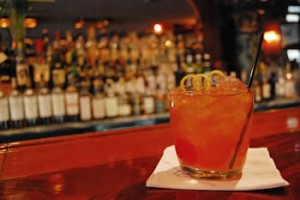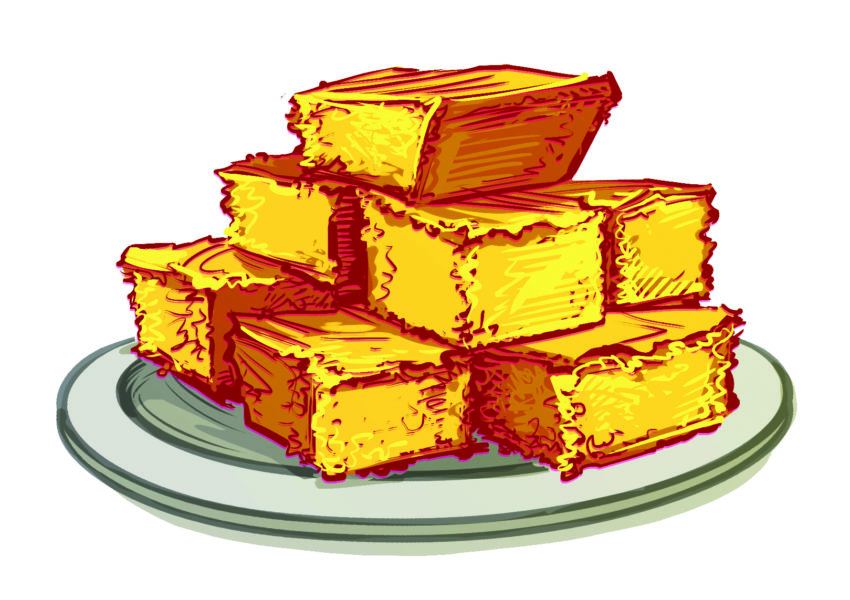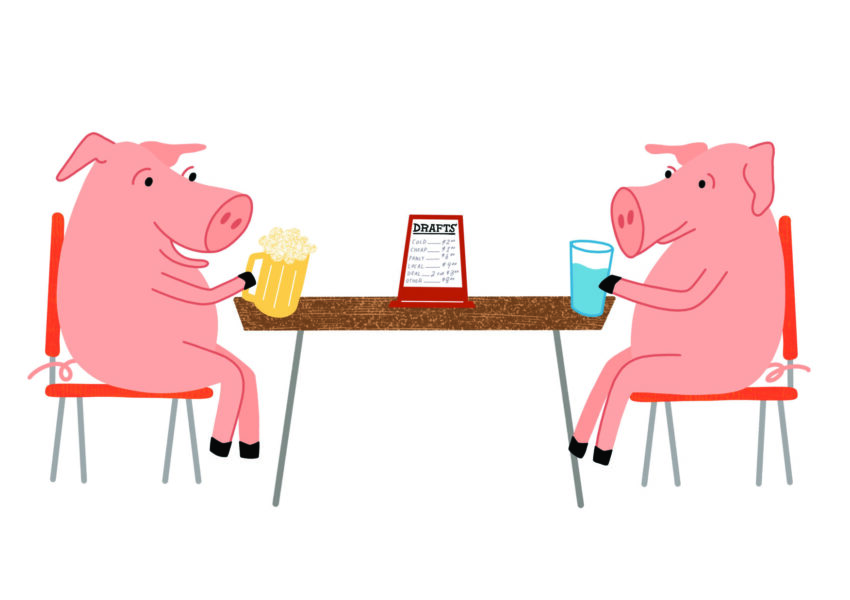A Shot of Truth Does a good story make a drink taste better?
By Wayne Curtis
It was 1917, and a bartender at the Seelbach Hotel in Louisville, Kentucky, was mixing several drinks at once. He opened a bottle of Champagne and—as Champagne will do—it cascaded over the top. Some of that fizz spilled into a Manhattan he’d already made. So he remade it, and set that original drink aside.
![]()
Later he tasted the original. It was fine. Good, even. It was bright and effervescent but still had the ballast of its era. The bartender added orange liqueur, and called it the Seelbach cocktail. He put it into regular rotation at the hotel. But the drink’s popularity was short-lived: Prohibition came along in 1920, and hotel bars like the Seelbach ran dry.
In 1995, Seelbach bar manager Adam Seger rediscovered the cocktail. He found it on an old bar menu in the hotel’s archives.

The drink appeared on the Louisville hotel’s cocktail menu once again—complete with story. Guests ordered it. Guests loved it. The Seelbach cocktail made its way into the slew of new books about classic cocktails, which seemed appropriate for a drink that came from a hotel that was itself so classic it got a passing mention in The Great Gatsby.
For the past twenty years, hotel visitors have walked through the ornate hotel lobby and ordered Seelbachs. It’s one of the bar’s best sellers.
Robert Simonson, a cocktail writer based in New York, tried one on a trip to Louisville about a decade ago. He hadn’t heard of the drink until a fellow journalist recommended it. Simonson remembers thinking it was a pretty good cocktail—not super-high on his list of favorites, but good. His experience at the Seelbach Hotel nearly ten years ago was typical. Go to the Seelbach. Order a Seelbach. Drink it.

Flash forward to 2016. Simonson was attending a small event to promote a new bar that Seger—now a well-known bar consultant—was opening in New York. From the stage, Seger mentioned that he’d recently confessed to another bartender that he’d actually made up the whole story behind the Seelbach.
At the end of the night, Simonson darted out of his seat and up to the stage. Seger agreed to go on the record about the Seelbach fiction.
Simonson’s article about the fictitious Seelbach came out in The New York Times last October. The headline read, “That Historic Cocktail? Turns Out It’s a Fake.”
You might think that Seger was then ostracized and embarrassed about lying, for creating alternative cocktail facts. But that didn’t happen—most cocktail writers and bartenders I’ve talked to just laughed, even those who included the fake story in their books, as Simonson did. Many complimented Seger on coming up with an utterly plausible and enduring story.

Seger, it turns out, found himself with a foot in each of two eras. One was in an era now gone, when good stories told at bars, about bars, and about drinks were the currency of the time. Everybody made things up. Nobody really cared—as long as the story was well told and entertaining.
Then, a little over ten years ago, I started hearing a phrase that I don’t think had ever been uttered before inside a bar: “What’s your source on that?”
A new generation of cocktail and spirits writers—and I include myself among them—had started sifting through the stories, trying to separate fact from fancy. How did this whiskey really arise? Which bartender first made that drink? Did the cocktail truly originate in New Orleans?
We wanted answers, and we wanted the truth. But I also wondered, what do we lose when we stop making up stories?
I’ve been writing about liquor, cocktails, and bars for more than a dozen years. I got into this because I was interested in the history of drink: why people drank, what they drank, what they were doing while they drank.
I started hearing a phrase that I don’t think had ever been uttered before inside a bar: “What’s your source on that?”
Two moments helped shaped how I think about stories and spirits—one took place in France, and the other in New Orleans.
In 2011, I toured a sprawling palace full of stained-glass windows near the Normandy coast in France where Bénédictine liqueur is manufactured. Its makers have long claimed that it was concocted from a rediscovered sixteenth-century recipe originally developed by Benedictine monks. In the mid-nineteenth century, someone supposedly found this recipe that called for distilling spirits and herbs and various other whatnot in an alchemy manuscript that had been hidden away, and decided to produce it again.

During the tour, I asked my guide where that manuscript was located.
“It’s in a safe in a secret location,” she said.
I pressed her. Is it somewhere in this area?
“It’s somewhere in Europe,” she replied. “I don’t think it’s in the United States.”
In other words, she had no idea—because there was no sixteenth-century manuscript. She was repeating a story that had been made up of whole cloth. It dates back to 1863, when a wealthy industrialist named Alexandre Le Grand started making an herbal liqueur. He knew that it needed a good story to go with it, and so in came the monks and the alchemy, followed by more than a century of fiction that all but morphed into fact.
Even that building I toured was something of a fake—a nineteenth-century reproduction of a fifteenth-century palace. It stood as a monument to how deeply and colorfully a good drinking story can embed itself in popular culture.
The second moment took place about a decade ago. I walked in to this tiny, four-seat bar at the Ritz-Carlton at the edge of the French Quarter in New Orleans with a couple of friends. A bartender the size of a fullback with a gravelly baritone voice loomed behind the bar. Among the drinks we ordered was a mint julep.
The bartender’s name was Chris McMillian. As he assembled his tools—a silver julep cup, a bar spoon, a canvas bag and massive wooden mallet for pulverizing the ice—he started reciting something. He began slowly and then picked up speed, like a stone rolling downhill.
Then comes the zenith of man’s pleasure. Then comes the julep, the mint julep. Who has not tasted one has lived in vain. The honey of Hymettus brought no such solace to the soul; the nectar of the Gods is tame beside it. It is the very dream of drinks, the vision of sweet quaffing… Sip it and dream, you cannot dream amiss, sip it and dream. It is a dream itself. No other land gives such sweet solace for your cares; no other liquor soothes you so in melancholy days. Sip it and say there is no solace for the soul, no tonic for the body like old bourbon whiskey. Cheers.
![]()

I was completely surprised. And confused. Was he talking to us? To himself? To an invisible friend? But within a minute or so, we were sucked in and pulled along on this journey of the mind. Upon finishing the ode, which was the length of a short book, McMillian slid the julep across to us.
To this day, it was the single best drink I’ve ever had, anywhere. Not because of the bourbon he used, nor his technique in pulverizing the ice to a fine powder—although those didn’t hurt—but because the drink came surrounded by this nimbus of soothing words. It turns out he was reciting an ode to the julep written in the 1890s by a Kentucky judge named Joshua Soule Smith, and which McMillian had long ago memorized and unspooled to guests when the mood struck him.

While that was the best julep I’ve ever had, the story has somehow infected my tastebuds, improving every julep I’ve had since. The same is true for Bénédictine. Even though I know the whole story of monks and alchemy is an elaborate bit of fakery, as is the fancy palace—I remember the echo of the creaky stairs, and I swear I can taste the monks’ handiwork every time I sip it.
To this day, it was the single best drink I’ve ever had, anywhere.
When I lived in New England, my neighbors and I talked to convey information—rarely more. Those who spoke most efficiently were the most respected. It was as if you were given an allotment of so many words to use during your time on Earth, and people were afraid they might run out. Living in New Orleans for the past decade, I’ve learned that’s not the case here. Information seems to be more a vehicle to get you to the digression, which is the whole point of talking to someone.
Today, we don’t so much tell stories as traffic in snippets—140 characters here, an Instagram caption there. We hit send, and then we sit and wait for someone to ping back.
Bars have been more or less resistant to these trends. Even though televisions mounted among the liquor bottles might offer an excuse not to talk, striking up a conversation with a complete stranger in a bar is still an accepted, even expected, part of going out for a drink.
Chris McMillian left the Ritz-Carlton years ago. He stopped reciting the ode to the julep when word got around, and tourists started coming in with expectations. He felt like a human jukebox—strangers would plop in a coin and wait for something to come out. The verse no longer surprised. McMillian and his wife, Laura, now have their own bar, called Revel, a couple of miles from the French Quarter just off Canal Street. Revel has no televisions—the McMillians want their customers to interact.

A 2004 scientific study published in the Journal of Sensory Studies examined how sound can influence taste. The title was “The Role of Auditory Cues in Modulating the Perceived Crispness and Staleness of Potato Chips,” which was a ten-dollar way of saying that if the chip sounded crisper, it tasted better. This might seem obvious—and a lot of people made fun of the study—but more revealing was the researcher’s look at how humans tend to involuntarily combine various sensory cues into one multisensory perception.
I’ve also turned up studies on how mood, music, appearance, texture, packaging, and the ambiance of where you drink can affect how you perceive the taste of whatever it is you’re eating or drinking. But I’ve found no studies on how a good story can affect taste.
I’m worried that we’re losing that part of taste. The modern cocktail revival has seen the rise of the elegant and often pricey craft cocktail, which you can order in all the new cool-kid bars. It has also seen the return of a class of professional bartender—folks who see this as their livelihood, not as a gig during grad school or between auditions. They have the time and motivation to get bartending right, with many of them worrying the details down to the last milliliter.
But deftness in behind-the-bar storytelling is lagging. The new crop of bartenders has by and large focused on eyedroppers of tinctures rather than on their customers. One bar consultant I know told me that he used to teach bar staff how to make drinks. Now, bar owners ask him to instruct the staff on how to tell a story, how to make eye contact, how to connect with the patrons.
As a journalist, I’m all for getting the facts right. But maybe we needn’t be so fastidious. Maybe letting a little fiction back into the bars isn’t a bad thing. Maybe we should let bars do what they do best, which is to serve as petri dishes where stories propagate and grow.
I was in Louisville a couple of months ago and stopped by the bar at the Seelbach Hotel, after Robert Simonson’s story about the big lie came out in The New York Times. The hotel is now a Hilton, and the bar has too many TV sets blaring for my taste. But I walked in and grabbed a stool and ordered a Seelbach. The bartender told me that the truth hadn’t gotten in the way of sales—it was still the bar’s top-selling cocktail.
I sipped it, and it tasted like a mistake made right. Later, back in New Orleans, I asked Chris McMillian if he thought the truth might diminish the taste of the Seelbach.
“No, it only enriches the story,” he said. “I’ve told the Seelbach story a bunch of times and now it has an addendum to it, that brings it up to contemporary times and relates it to an individual person and their personal experience.”
The truth makes a nice frame for a drink. But I’m thinking the story is always what will set it apart.
Wayne Curtis is a New Orleans-based writer and the author of And a Bottle of Rum: A History of the New World in Ten Cocktails. A version of this story aired on Gravy podcast episode 63, Booze Legends.




